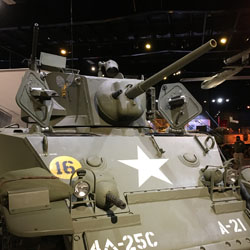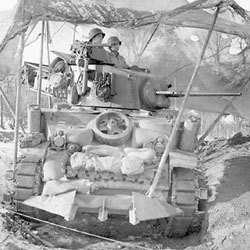The M5 “Stuart” was an extension of the original M3 Stuart Light Tank line of 1941. The British called it ‘Stuart’ in honor of American general Jeb Stuart.
The M5 had a paired set of Cadillac V8 296-horsepower automobile engines. The engines were coupled to individual Hydra-Matic transmission systems running through a 2-speed transfer case. A new front hull design, based on the M3A3 Stuart, improved frontal ballistics protection. The lack of a frontal vertical face on the new hull superstructure ended with the driver’s hatch relocated to the hull roof. The M5 carried the 37mm M6 main gun which gave good service against light-armored vehicles, light fortifications and enemy infantry (the latter when using High-Explosive (HE) projectiles). Defense was through a coaxial 0.30 Browning machine gun as well as a bow-mounted machine gun at front-right. The M5 much roomier interior compared to the M3 that preceded it. It took a crew of four – driver, commander, gunner and bow machine gunner/radio operator.
The M5 line served in a frontline role as the primary American light tank until 1944. M5 Light Tanks operated primarily in the Pacific and Burmese theaters where Japanese armor was comparable and its anti-weaponry was not as potent as what was seen with the Germans in Africa and Europe. It was during the 1943 Battle of Kasserine Pass that showcased the critical tactical limitations of light tank battalions for the U.S. Army. This led to their disbanding and reforming with medium tank companies while being used primarily in the armed scouting / reconnaissance role.
Most notable about the AHM Stuart is this is the first tank Jacques Little field acquired, starting off what would be the world’s largest privately held collections of tanks and armored vehicles.






